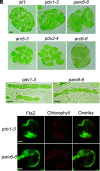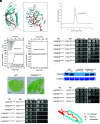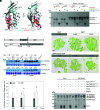Structural and functional insights into the chloroplast division site regulators PARC6 and PDV1 in the intermembrane space
- PMID: 36696445
- PMCID: PMC9945983
- DOI: 10.1073/pnas.2215575120
Structural and functional insights into the chloroplast division site regulators PARC6 and PDV1 in the intermembrane space
Abstract
Chloroplast division involves the coordination of protein complexes from the stroma to the cytosol. The Min system of chloroplasts includes multiple stromal proteins that regulate the positioning of the division site. The outer envelope protein PLASTID DIVISION1 (PDV1) was previously reported to recruit the cytosolic chloroplast division protein ACCUMULATION AND REPLICATION OF CHLOROPLAST5 (ARC5). However, we show here that PDV1 is also important for the stability of the inner envelope chloroplast division protein PARALOG OF ARC6 (PARC6), a component of the Min system. We solved the structure of both the C-terminal domain of PARC6 and its complex with the C terminus of PDV1. The formation of an intramolecular disulfide bond within PARC6 under oxidized conditions prevents its interaction with PDV1. Interestingly, this disulfide bond can be reduced by light in planta, thus promoting PDV1-PARC6 interaction and chloroplast division. Interaction with PDV1 can induce the dimerization of PARC6, which is important for chloroplast division. Magnesium ions, whose concentration in chloroplasts increases upon light exposure, also promote the PARC6 dimerization. This study highlights the multilayer regulation of the PDV1-PARC6 interaction as well as chloroplast division.
Keywords: PARC6; PDV1; chloroplast division; crystal structure; intermembrane space.
Conflict of interest statement
The authors declare no competing interest.
Figures









Similar articles
-
Roles of Arabidopsis PARC6 in Coordination of the Chloroplast Division Complex and Negative Regulation of FtsZ Assembly.Plant Physiol. 2016 Jan;170(1):250-62. doi: 10.1104/pp.15.01460. Epub 2015 Nov 2. Plant Physiol. 2016. PMID: 26527658 Free PMC article.
-
PARC6, a novel chloroplast division factor, influences FtsZ assembly and is required for recruitment of PDV1 during chloroplast division in Arabidopsis.Plant J. 2009 Sep;59(5):700-11. doi: 10.1111/j.1365-313X.2009.03905.x. Epub 2009 May 2. Plant J. 2009. PMID: 19453460
-
PDV1 and PDV2 mediate recruitment of the dynamin-related protein ARC5 to the plastid division site.Plant Cell. 2006 Oct;18(10):2517-30. doi: 10.1105/tpc.106.045484. Epub 2006 Sep 22. Plant Cell. 2006. PMID: 16998069 Free PMC article.
-
Division and dynamic morphology of plastids.Annu Rev Plant Biol. 2014;65:443-72. doi: 10.1146/annurev-arplant-050213-035748. Epub 2014 Jan 22. Annu Rev Plant Biol. 2014. PMID: 24471836 Review.
-
Insights into the Mechanisms of Chloroplast Division.Int J Mol Sci. 2018 Mar 4;19(3):733. doi: 10.3390/ijms19030733. Int J Mol Sci. 2018. PMID: 29510533 Free PMC article. Review.
Cited by
-
Filamentous Temperature-Sensitive Z Protein J175 Regulates Maize Chloroplasts' and Amyloplasts' Division and Development.Plants (Basel). 2025 Jul 16;14(14):2198. doi: 10.3390/plants14142198. Plants (Basel). 2025. PMID: 40733435 Free PMC article.
-
Evolution and Functional Differentiation of the C-terminal Motifs of FtsZs During Plant Evolution.Mol Biol Evol. 2024 Jul 3;41(7):msae145. doi: 10.1093/molbev/msae145. Mol Biol Evol. 2024. PMID: 39004892 Free PMC article.
-
Editorial: Structure and function of chloroplasts, Volume III.Front Plant Sci. 2023 Mar 1;14:1145680. doi: 10.3389/fpls.2023.1145680. eCollection 2023. Front Plant Sci. 2023. PMID: 36938040 Free PMC article. No abstract available.
-
Integrated genomic and transcriptomic analysis reveals the mechanisms underlying leaf variegation in 'Gonggan' mandarin.BMC Plant Biol. 2025 Apr 15;25(1):472. doi: 10.1186/s12870-025-06496-9. BMC Plant Biol. 2025. PMID: 40229686 Free PMC article.
-
Increasing amyloplast size in wheat endosperm through mutation of PARC6 affects starch granule morphology.New Phytol. 2023 Oct;240(1):224-241. doi: 10.1111/nph.19118. Epub 2023 Jul 10. New Phytol. 2023. PMID: 37424336 Free PMC article.
References
-
- Osteryoung K. W., Nunnari J., The division of endosymbiotic organelles. Science 302, 1698–1704 (2003). - PubMed
-
- Osteryoung K. W., McAndrew R. S., The plastid division machine. Annu. Rev. Plant Physiol. Plant Mol. Biol. 52, 315–333 (2001). - PubMed
-
- Osteryoung K. W., Pyke K. A., Division and dynamic morphology of plastids. Annu. Rev. Plant Biol. 65, 443–472 (2014). - PubMed
-
- Yoshida Y., Mogi Y., TerBush A. D., Osteryoung K. W., Chloroplast FtsZ assembles into a contractible ring via tubulin-like heteropolymerization. Nat. Plants 5, 119–119 (2016). - PubMed
Publication types
MeSH terms
Substances
LinkOut - more resources
Full Text Sources
Molecular Biology Databases
Research Materials

